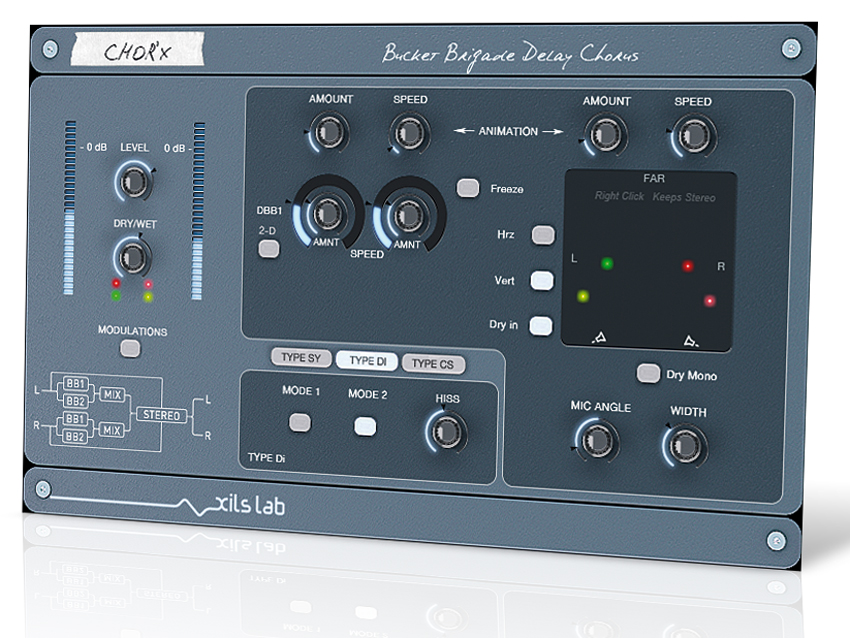MusicRadar Verdict
Quirky and characterful, Chor'X combines retro-style chorusing with true stereo signal placement to good effect.
Pros
- +
Excellent stereo effect; rich retro sound with adjustable hiss; extensive presets and preset management options; good value.
Cons
- -
Interface learning curve; no tempo sync!
MusicRadar's got your back
There are plenty of chorus plug-ins around, some of them emulating revered classics such as Electro-Harmonix's Small Stone or Roland's Dimension D.
Chor'X from XILS-lab takes a different path, emulating the bucket brigade delay technology found in a range of venerable hardware but beefing it up with numerous modern features. The result is a 'true stereo' processor that uses up to four bucket brigade delays to deliver two independent (left and right) chorus processors.
This basic process is then coupled with further 'chaotic' modulation options and XILS-lab's True Stereo Dynamic Engine for highly controllable stereo placement.
Chor'X is a VST/AU/RTAS plug-in for PC and Mac. It includes three separate chorus types, each modelled on a specific (unnamed) hardware unit: Sy, Di and Cs.
Sy comprises two BBDs modulated by two LFOs per channel; Di has one BBD per channel and one LFO (inverted on one channel); and Cs houses one BBD per channel and two LFOs (which also modulate the level). All types also get a Hiss control for dialling in some vintage noise and dirt.
The true stereo positioner provides independent control over left/right channel signal placement for both wet and dry signals. Finally, the Modulations button activates impulse and envelope follower options, used for transient retention and chorus depth modulation respectively.
X/Y control
There's a lot going on here, and the first step to negotiating it all is understanding the X/Y pads and what they display.
Chor'X features two X/Y control pads, one for each process (chorus and stereo). Both use colour-coded dots (green/yellow = left, red/pink = right) for operation and visual feedback. The Sy chorus (see below) employs all four colours, as does the stereo processor, which uses them to differentiate between dry and wet signals. The global wet/dry control influences dot brightness on the stereo processor, but the Sy chorus' BBD mix controls don't offer the same feature, oddly. While mic separation can be adjusted with the X/Y controls, the knobs below have to be used to set the space width and mic angle.
With animation switched off, the dots are stationary; wind the Animation Amount up and you start to see movement. Changes can be limited to the horizontal or vertical planes using the side buttons, and there's a Freeze option for the chorus. Right-click dragging in the chorus area moves all dots while retaining their relative positions.
Fattening up
Chor'X comes with 128 instrument-categorised presets (guitar, pad, etc), which serve both as good starting points and as ready-made effects.
The three chorus types all sound markedly different. The complexity of Sy mode makes it the most flexible, and with fast modulation settings it can produce odd, twangy sounds. However, it's at its best adding slow complex modulation to mundane pads.
Diand Cs are easier to handle, with Cs sounding much narrower than Di. Cs works really well for subtle chorus on acoustic guitar, while Di delivers the far more obvious sound of an electric guitar chorus pedal. All three chorus types benefit from the edge-adding Hiss effect.
The stereo processor enables you to take theoverall effect some way beyond being 'just' chorus, particularly if you process the dry signal too. Throw in some animation and things can get pretty smeared; turning animation off is the best way to go for accurate positioning of sounds.
We're very impressed not only by Chor'X's ability to place sounds both left-to-right and near-to-far, but also the fact that it does it independently for the processed and dry signals.
Finally, we had great success with the impulse detector, which retains transients for drums, guitars, etc. Grab the green dot to enter transient listen mode, move it to set the threshold, then set the desired mix level.
There are various display options on offer, including a BPM setting for the modulations, but unfortunately no method for syncing Chor'X to host tempo. Our only other gripe is that with so many parameters, coaxing out the exact sound you're after can take time.
Nevertheless, Chor'X sounds good and represents great value.
Computer Music magazine is the world’s best selling publication dedicated solely to making great music with your Mac or PC computer. Each issue it brings its lucky readers the best in cutting-edge tutorials, need-to-know, expert software reviews and even all the tools you actually need to make great music today, courtesy of our legendary CM Plugin Suite.
“A synthesizer that is both easy to use and fun to play whilst maintaining a decent degree of programming depth and flexibility”: PWM Mantis review
“I feel like that song had everything we needed to come back with”: Bring Me The Horizon’s Lee Malia on Shadow Moses, its riff and the secrets behind its tone, and why it was the right anthem at the right time
“I said, ‘Are we sure we can write a song about death?’”: The story of Mike + The Mechanics' classic No.1 The Living Years











